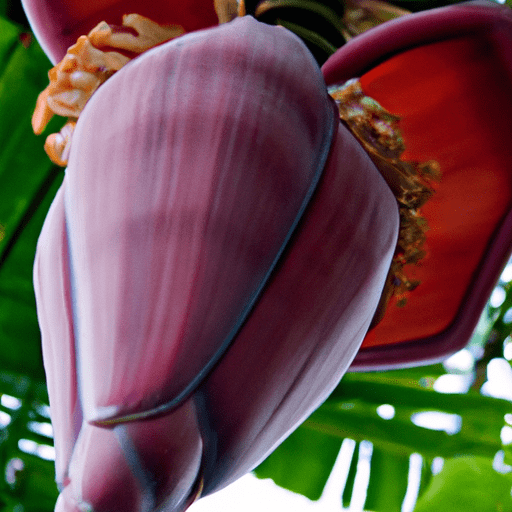Exploring the Beauty and Bounty of Banana Blossom
If you thought bananas were just about the fruit, think again! The often-overlooked yet fascinating banana blossom, also known as a banana heart, is a culinary treasure that deserves our attention. With its delicate taste, unique texture, and a wide array of uses, the banana blossom is a versatile ingredient that adds depth and variety to many dishes.
Taste and Texture
The banana blossom’s taste can be described as subtly bitter and tangy, with a hint of sweetness. Its flavor profile resembles a delicate blend of artichoke hearts and hearts of palm, delivering a unique and delightful gustatory experience. The blossom itself possesses a tender yet fibrous texture that adds a pleasant crunch to any dish it graces. When properly prepared, the banana blossom offers a satisfying eating experience that’s both refreshing and satisfying.
Culinary Applications
Banana blossoms are used across a variety of cuisines, especially in Southeast Asia, where they are prized for their versatility and flavor. In Filipino cuisine, the blossom shines in the traditional dish known as “Ginataang Puso ng Saging,” which features the blossom cooked in coconut milk with spices and other ingredients. The banana blossom is also a staple ingredient in Thai salads such as “Yum Hua Plee,” where it provides a delightful contrast to the fresh herbs and zesty dressing.
Beyond Southeast Asia, banana blossoms can be found in Indian, Vietnamese, and Indonesian cooking. In Indian cuisine, the blossom is often used in curries and chutneys, imparting a unique taste to the dish. Vietnamese cuisine features the banana blossom in its famous “Goi Chuoi Tom Thit,” a salad that combines the blossom with shrimp and pork for a delectable feast of flavors and textures. Indonesian cuisine also showcases the blossom in a myriad of dishes, including stews, soups, and sambals.
Nutritional Value
In addition to its culinary appeal, the banana blossom boasts numerous health benefits. Packed with vitamins and minerals, this beautiful blossom provides a nutritious punch while being low in calories. It is an excellent source of Vitamin C, which supports the immune system and promotes collagen production. The blossom also contains essential minerals like potassium, magnesium, and manganese, which contribute to healthy bodily functions.
Moreover, the banana blossom is rich in dietary fiber, which aids digestion and helps maintain a healthy digestive system. Additionally, it possesses antioxidant properties that help combat harmful free radicals, protecting the body against various diseases and supporting overall well-being.
Fascinating Facts and History
Beyond its culinary applications and nutritional value, the banana blossom has an intriguing history and several interesting facts surrounding it. Here are some captivating tidbits:
- The banana blossom is the flower of the banana plant, which is the world’s largest herbaceous flowering plant.
- The blossoms start as purple or maroon-colored buds and gradually transform into stunning blossoms.
- In some cultures, the banana blossom is believed to have medicinal properties and is used to treat various conditions.
- Banana blossoms are often harvested just before the banana fruit itself ripens.
- The tough outer layers of the blossom need to be peeled away to reveal the tender, edible layers within.
Bringing Banana Blossom into Your Kitchen
Now that you’re acquainted with the wonders and uses of the banana blossom, it’s time to incorporate it into your own culinary adventures. Though it may require a bit of preparation, the end result will undoubtedly be worth the effort. Whether you experiment with traditional Southeast Asian recipes or embark on your own creative culinary journey, the banana blossom is sure to elevate your dishes and delight your taste buds.
So, step out of your comfort zone and embrace the captivating beauty of the banana blossom. Unleash your culinary prowess and discover the endless possibilities this unique ingredient offers.
Banana Blossom
Origin: Banana blossom, also known as banana flower, is the flower of the banana tree (Musa species), which is native to Southeast Asia. It is found in countries such as India, Thailand, Indonesia, and the Philippines, where it is used extensively in local cuisine.
Common Uses: Banana blossom is used in various culinary preparations. In Southeast Asian cuisines, it is commonly used in salads, curries, stir-fries, soups, and stews. The young, tender blossoms are usually preferred as they have a milder flavor. It is often used as a meat substitute in vegetarian and vegan dishes due to its texture and ability to absorb flavors.
Nutritional Benefits: Banana blossom is a good source of dietary fiber, potassium, vitamin C, and antioxidants. It also contains flavonoids and tannins that have potential health benefits. It is low in calories and fat, making it a healthy addition to balanced diets.
Unique Properties: The banana blossom is composed of tightly packed purple or maroon-colored bracts (modified leaves), which protect the flowers within. The individual bracts need to be peeled back to reach the tender and edible parts. The edible portion of the blossom includes the inner, pale yellow-colored florets, which can be separated and used in cooking. The blossom has a slightly bitter taste, which can be reduced by soaking it in water with a bit of lemon juice or vinegar.
Historical Significance: Banana blossom has been used in traditional medicine in many Asian cultures for centuries. It is believed to have various health benefits such as treating menstrual disorders, improving lactation, reducing constipation, and promoting heart health. It has also been used to alleviate symptoms of diabetes and to aid in weight loss, although scientific research in these areas is limited.
Please note that while banana blossom is widely consumed in certain regions, it may not be as readily available in all parts of the world.




Use the share button below if you liked it.
It makes me smile, when I see it.